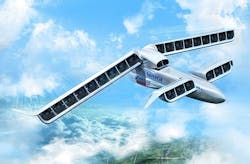Aurora Flight Sciences prevails over three competitors to develop high-speed DARPA VTOL X-Plane
Officials of the U.S. Defense Advanced Research Projects Agency (DARPA) in Arlington, Va., announced an $89.4 million downselect contract to Aurora Flight Sciences Thursday for the second and third phases of the Vertical Take-Off and Landing Experimental Plane (VTOL X-Plane) project.
Since late 2013 Aurora engineers have been conducting trade studies and develop the VTOL X-Plane's initial design. Aurora prevails over competitors Sikorsky Aircraft Corp., a Lockheed Martin company in Stratford, Conn.; Karem Aircraft Inc. in Lake Forest, Calif.; and the Boeing Co. Defense, Space & Security segment in St. Louis to design and test a VTOL X-Plane prototype.
The second phase of the DARPA VTOL X-Plane program will involve design, development, and integration, and the third phase will involve flight-test demonstrations. Aurora is working with team members Rolls-Royce PLC in Manchester, England, and Honeywell International Inc. in Morris Plains, N.J., on the VTOL X-Plane project.
The Aurora team will build a prototype VTOL X-Plane with a distributed hybrid-electric propulsion system that is based on the Aurora unmanned LightningStrike aircraft.
Related: Aurora Flight Sciences joins Sikorsky in next phase of project to design new tiltrotor
Aurora’s LightningStrike design includes distributed hybrid-electric propulsion ducted fans; a synchronous electric-drive system; tilt-wing- and tilt-canard-based propulsion for vertical takeoff and landing; and high efficiency in hover and fast forward flight.
story continues below
The aircraft design features a Rolls-Royce AE 1107C turboshaft engine that will power three Honeywell generators, and 24 ducted fans distributed on the wings and canards. Flight tests are scheduled for 2018.
The VTOL X-Plane effort is a four-year $130 million effort to fly an experimental aircraft that flies faster than 300 knots with a hover efficiency of 75 percent or better and a cruise lift-to-drag ratio of 10 or more.
The Boeing V-22 Osprey tiltrotor is one of the first VTOL aircraft deployed with U.S. forces. It has a top speed of 275 knots. The DARPA VTOL X-Plane project has a goal of increasing VTOL aircraft speed to at least 400 knots -- or about the cruise speed of small business jets.
The VTOL X-Plane program seeks to achieve its speed goals through cross-pollination between the fixed-wing and rotary-wing worlds to achieve radical improvements in VTOL flight, DARPA officials say.
Related: U.K. and U.S. show off F-35 and Sea Harrier VTOL aircraft
Aurora Flight Sciences engineers will design a hybrid aircraft that will push VTOL limits in speed, hover efficiency, cruise efficiency, and useful load.
The VTOL X-Plane project is aiming at a top sustained flight speed of 300 to 400 knots; hover efficiency of at least 75 percent; cruise efficiency lift-to-drag ratio of at least 10; and useful load capacity of at least 40 percent of the vehicle’s projected gross weight of 10,000 to 12,000 pounds.
On this contract the Aurora Flight Sciences team will do the work in Manassas, Va.; Indianapolis; Tucson, Ariz.; and Ventura, Calif., and should be finished by September 2018.
For more information contact Auroral Flight Sciences online at www.aurora.aero, or DARPA at www.darpa.mil.
